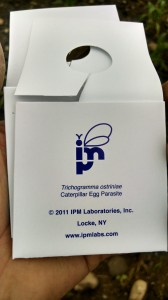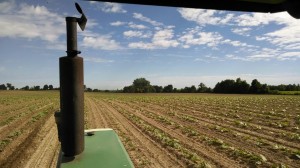Weather plays an enormous role in agriculture. During the final week of my internship we got over six inches of rain on Monday and 3/4 inch hail a few days later. The rain kept us out the fields for the rest of the week unless we had no choice.
We were in the heat of squash harvest season, and if you have ever grown squash, they don’t stay the ideal size for very long. Despite the deep mud the tractors, trailers, and workers ventured out into the fields, and commenced to get stuck a lot. They got stuck so much that it was worth it to pay someone to sit in a tractor just ahead of the one pulling the harvest wagon in order to pull it out whenever it got stuck. They came back completely cover in mud . The hail did not hit too many of our fields, but the fields that were hit were decimated. The corn was shredded and the pickling cucumbers were pounded into the ground. I had never seen anything like it.
I spent most of my final days in the hopyard repairing the infrastructure. The hopyard is the seven acre field where the hops are grown. Hops are climbing vines and thus require a huge amount of infrastructure. In short there are a lot of telephone poles and a lot of wire crossing the tops of the poles with twine for the vines to grow up hanging in long rows. The weight of the maturing hops combined with the severe weather was too much for some of the poles to withstand, and so they snapped in half. I, along with my colleague, Ciro, spent several days using a loader and an off-road forklift, along with some other tools like an impact driver and a posthole digger, to disconnect the wires, pull out the broken poles, re-dig the holes, put the new poles in at a 65 degree or so angle, and secure them down.
That concludes my summer internship with Pedersen Farms. It was an eyeopening experience which I am very glad I got. The most important thing I learned over the course of this internship is that you learn by screwing up. Honestly that is probably how I learned most of the things I did. Even after a moment or two of doubt at the beginning, I am still confident this is the right career path for me.











